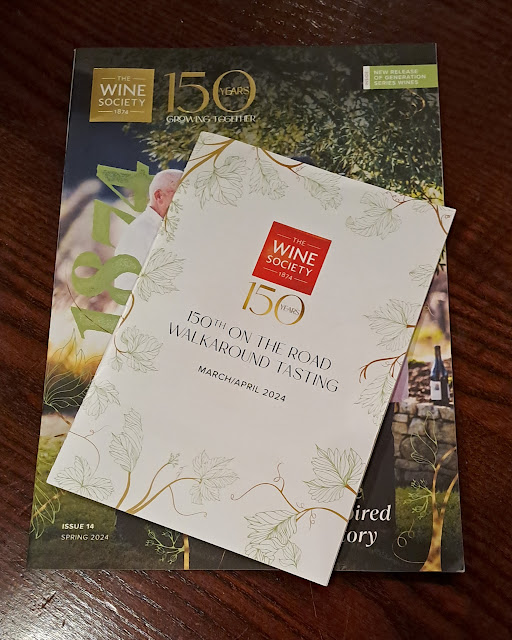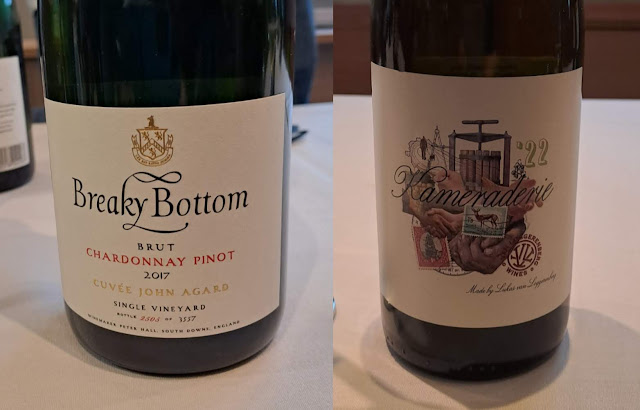The Wine Society are hosting a number of tastings to celebrate their 150 years, the recent tasting in Birmingham was focussed on their second 50 year period. The wines exhibited were defined into five categories:
Generation series - focusing on 1924 to 1974
Anniversary range - limited collection of fine wine
1936 The first six appellations in France - Cassis, Tavel, Arbois, Chateauneuf-du-Pape, Monbazillac and Cognac
1964 Bag-in-Box patented in Australia - highlighting sustainability
Making moves outside mainland Europe - changes in the wider world of wine
With such a variety of wine it was not really possible to taste in style order which is always a slight issue at large tastings using the same glass however there was plenty of water available. As there was no tasting order and table 1 was at the far end on the room we decided to start at the nearest table and worked our way around the room initially tasting only the white wines exhibited before retracing our route to enjoy the red wines.
As with all tastings not all wines were to my taste but it was a super opportunity to taste so many varieties. All the wines were detailed in a great tasting booklet, I have reviewed the wines I photographed and a few favourites my camera missed.
Our starting wine was from the 1964 Bag-in-Box category, although this revolutionary technique started in Australia the white wine was from France (the red which we tasted later was Californian), hopefully the Wine Society will soon include a Bag-in-Box selection from the pioneering country. That said the Society's White Burgundy was a lovely wine to begin our tasting, it had a balanced minerality with a clean stone fruit flavour.
An English sparkling wine began our 'Making moves outside mainland Europe' selection. Produced by Peter Hall who planted his Sussex Downs vineyard in 1974 Cuvée John Agard, Breaky Bottom this sparkling wine was 65% Chardonnay giving a full citrus flavour.
Van Loggerenberg 'Kamaraderie' Chenin Blanc from Swartland South Africa drew my attention with it's striking label. In fact many of the wines at the tasting had special labels for the Wine Society's celebrations. This Chenin Blanc had lovely soft flavours of green apple and lime but was a pricey wine at £34.
Of the five categories I was most looking forward to 'Generation Series 1924-1974' as it included Domaine Jaume from France. As they are red wine producers our visit to this section of the tasting began with Cava Gran Reserva Brut, a dry sparkling wine with a toasty flavour.
This category also included three white wines produced by the Hugel family in the Alsace region of France. Gentile was a gentle wine with a hint of minerality. The other two wines, Vin d'Alsace and Gewurztraminer, were both full of flavour and great representations of this region and it's German influences.
My favourite white at the tasting was from the 150th Anniversary Series and was the highest priced at £45. Surprisingly it was not a Sauvignon Blanc but a oak aged, complex, rounded Chardonnay, definitely a step above giving a true definition of fine wine.
In my enjoyment of the Chardonnay I missed taking g a photograph but I did take one of the other white wine in the Anniversary series, Hunter Valley Semillon. A soft wine with apple and lime flavours with a dry finish.
Staying with the fine wines we moved on to tasting the reds beginning with The Society's 150th Anniversary Amarone 2018. Fermented in stainless steel vats this blend of Corvina, Corvinone, Rondinella and Oselea is then aged in new oak for 18 months. The dominant flavour for me was dried prunes but I found the wine a little too tannic although it did soften in the glass.
The other red celebrating the Society's 150th Anniversary was Geyserville Zinfandel 2019 from California. A blend full of black fruits especially cherries and a hint of liquorice this wine had plenty of flavour, a little pricy at £39
Two red wines I was very keen to taste were from Domaine Jaume in Vinsorbes France. We visited here in 2016 during our visit to the
Cotes du Rhone region. The Jaume family are featured on the front of The Wine Society's Magazine celebrating the generations of winemakers.
Vinsorbes Altitude 420 and The Wine Society's Generation Series Vinsorbes are both made from Grenache and Syrah grapes with their raspberry flavours and touch of spice finishes. Having visited Vinsorbes it is certainly on steep slope enjoying the south sun and breezes from the mountains. I enjoyed both of these wines which brought back great memories of our visit, one we hope to repeat one day.
My favourite red was also from the Generation Series, Chateau Le Boscq, Saint-Estephe 2016. This northern Medoc wine was very smooth, had plenty of flavour and a long satisfying finish. '
Amongst the array of white and red wines were two that stood alone, firstly Tavel Cuvée Prima Donna Rose from Domaine Maby. I discovered Tavel on recommendation from Heather Dougherty and although it isn't a wine I often drink I really do enjoy it. It's a wine that matches perfectly to light meals especially lunches in the garden on a sunny day.
Thje second wine being a dessert wine which, like the Tavel, was in the 1936 first six appellations in France selection. Monbazillac Chateau Pech La Calvie was full of peaches and honey, a fully flavoured wine that was crying out to be paired with cheese and nuts.
The final tasting was The Society's Cognac, again celebrating France's appellations. Distilled at Chateau d'Orignac this superb Cognac had been oak aged for longer than the appellations requirement of four years. It was filled with rich flavours of dried fruits and nuts with a hint of woodiness that added to its lengthy finish.
Wine tastings are always an enjoyable event, a chance to try wines I probably wouldn't choose for myself and to learn more from fellow wine drinkers. Our home location does not always make it easy for us to access many of the events so when The Wine Society's 150th Anniversary tastings included Birmingham we were delighted to attend. It was a great evening with some superb wines, thank you.


















































